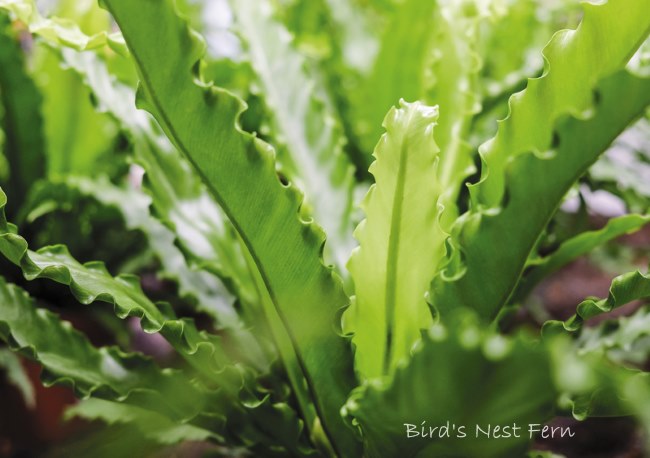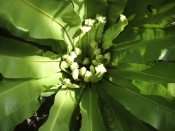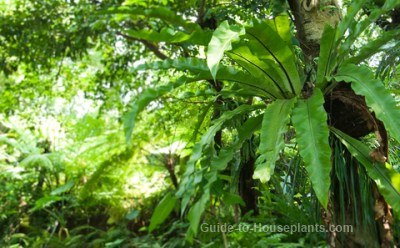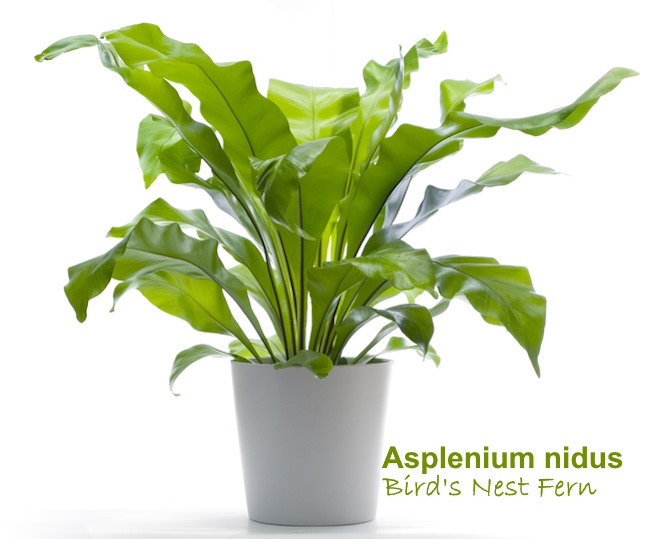Bird Nest Fern
Bird nest fern is one of the easiest types of ferns to grow indoors. Known botanically as Asplenium nidus, this tropical native is fast-growing and will live for many years with good care.
Discover how much light, water and humidity it wants, plus when to repot this beautiful houseplant.

Get to Know Bird Nest Fern
In its natural habitat of Southeast Asia and Tropical Australia, Asplenium nidus grows as an epiphyte (a plant that grows on trees) in the warm, moist, tropical rain forests.
It grows in the form of a deep rosette of large, shiny, spear-shaped fronds. New fronds unfurl from the center of the plant. Its fronds are fragile, so I'd put this fern where passersby won't brush up against it.

Bird's nest fern gets its name from the unfurled fronds in the center of the plant that look like eggs in a nest. In its native habitat, those fronds quickly reach 4 ft (1.2m) long.
How big does bird's nest fern get indoors? Grown in a container, this fern will reach a height of about 2 ft (60 cm).
Despite its tropical beginnings, bird nest fern adapts well to being a houseplant. Place your potted fern where it is out of direct sun and away from drafts, which can scorch the fronds. Provide humidity and you'll keep it healthy.
 Asplenium nidus grows on trees in its native habitat.
Asplenium nidus grows on trees in its native habitat.Bird's Nest Fern Problems, Solutions and Answers
As bird nest fern ages, the oldest, outer fronds will turn brown. This is normal. You can cut them off near the soil level to keep the plant looking neat.
Those upright fronds tend to be dust-catchers. Keep the broad, shiny fronds dust-free by gently wiping them with a damp cloth. Never use leaf shine products on ferns because it can severely damage their delicate fronds and may interfere with photosynthesis.
Repot young plants in spring, every couple years or when the roots fill the pot. If you find that the roots are attached to the pot, run a knife around the inside to loosen them before you can remove the rootball. You may need to break the pot to remove it. It's a good idea to use a container with drainage holes to avoid soggy soil. Take care not to pack down the potting mix; bird's nest fern likes a loose mixture.
This fern's problems are few. Watch for scale insects, that look like small, brown discs on fronds. If you find an invasion of these pests, spray with soapy water followed by clean water. Don't use insecticides on ferns because they are easily damaged by chemicals.
 Photo: istockphoto.com
Photo: istockphoto.comBird Nest Fern Indoor Care Tips
Light: Give your plant bright, indirect sunlight. No direct sun, which can scorch the fronds. Give the pot a quarter turn each week for even growth.
Water: Keep soil evenly moist. Use a pot with drainage holes to prevent overwatering. Water the potting mix, not the center of the rosette, otherwise it can easily rot. Water less in winter when growth is slower. Yellow fronds are often a sign of overwatering.
Humidity: This tropical fern likes moist air. If the relative humidity drops below 50%, use a humidity tray or cool-mist room humidifier to add moisture to the air around the fern. Brown leaf tips are a sign of dry air.
Temperature: Slightly cool to average room temps (60-75°F/16-24°C) suit this tropical fern just fine. Keep your houseplant away from cold blasts near doors or from heat/AC vents, which can change the temperature dramatically.
Soil: Peat moss based, such as African violet potting mix.
Fertilizer: Feed every 2 weeks in spring and summer with a balanced (such as 10-10-10 NPK) water-soluble fertilizer at half strength. Stop fertilizing in fall and winter, when growth is slow.
Propagation: Bird's nest fern is propagated by spores, which is difficult to do for the home grower.


